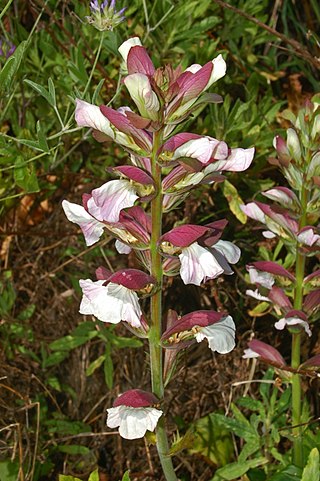
The Ericaceae are a family of flowering plants, commonly known as the heath or heather family, found most commonly in acidic and infertile growing conditions. The family is large, with c. 4250 known species spread across 124 genera, making it the 14th most species-rich family of flowering plants. The many well known and economically important members of the Ericaceae include the cranberry, blueberry, huckleberry, rhododendron, and various common heaths and heathers.

Linnaean taxonomy can mean either of two related concepts:
- The particular form of biological classification (taxonomy) set up by Carl Linnaeus, as set forth in his Systema Naturae (1735) and subsequent works. In the taxonomy of Linnaeus there are three kingdoms, divided into classes, and they, in turn, into lower ranks in a hierarchical order.
- A term for rank-based classification of organisms, in general. That is, taxonomy in the traditional sense of the word: rank-based scientific classification. This term is especially used as opposed to cladistic systematics, which groups organisms into clades. It is attributed to Linnaeus, although he neither invented the concept of ranked classification nor gave it its present form. In fact, it does not have an exact present form, as "Linnaean taxonomy" as such does not really exist: it is a collective (abstracting) term for what actually are several separate fields, which use similar approaches.

Mycology is the branch of biology concerned with the study of fungi, including their genetic and biochemical properties, their taxonomy and their use to humans, including as a source for tinder, traditional medicine, food, and entheogens, as well as their dangers, such as toxicity or infection.

Biological systematics is the study of the diversification of living forms, both past and present, and the relationships among living things through time. Relationships are visualized as evolutionary trees. Phylogenies have two components: branching order and branch length. Phylogenetic trees of species and higher taxa are used to study the evolution of traits and the distribution of organisms (biogeography). Systematics, in other words, is used to understand the evolutionary history of life on Earth.

In biology, taxonomy is the scientific study of naming, defining (circumscribing) and classifying groups of biological organisms based on shared characteristics. Organisms are grouped into taxa and these groups are given a taxonomic rank; groups of a given rank can be aggregated to form a more inclusive group of higher rank, thus creating a taxonomic hierarchy. The principal ranks in modern use are domain, kingdom, phylum, class, order, family, genus, and species. The Swedish botanist Carl Linnaeus is regarded as the founder of the current system of taxonomy, as he developed a ranked system known as Linnaean taxonomy for categorizing organisms and binomial nomenclature for naming organisms.

In taxonomy, binomial nomenclature, also called binominal nomenclature or binary nomenclature, is a formal system of naming species of living things by giving each a name composed of two parts, both of which use Latin grammatical forms, although they can be based on words from other languages. Such a name is called a binomial name, a binomen, binominal name or a scientific name; more informally it is also historically called a Latin name.
Order is one of the eight major hierarchical taxonomic ranks in Linnaean taxonomy. It is classified between family and class. In biological classification, the order is a taxonomic rank used in the classification of organisms and recognized by the nomenclature codes. An immediately higher rank, superorder, is sometimes added directly above order, with suborder directly beneath order. An order can also be defined as a group of related families.

Species Plantarum is a book by Carl Linnaeus, originally published in 1753, which lists every species of plant known at the time, classified into genera. It is the first work to consistently apply binomial names and was the starting point for the naming of plants.

Acanthus mollis, commonly known as bear's breeches, sea dock, bear's foot plant, sea holly, gator plant or oyster plant, is a species of plant in the family Acanthaceae and is native to the Mediterranean region. It is a leafy, clump-forming perennial herb, with a rosette of relatively large, lobed or toothed leaves, and purplish and white flowers on an erect spike.

Supplementum Plantarum Systematis Vegetabilium Editionis Decimae Tertiae, Generum Plantarum Editiones Sextae, et Specierum Plantarum Editionis Secundae, commonly abbreviated to Supplementum Plantarum Systematis Vegetabilium or just Supplementum Plantarum, and further abbreviated by botanists to Suppl. Pl., is a 1782 book by Carolus Linnaeus the Younger. Written entirely in Latin, it was intended as a supplement to the 1737 Genera Plantarum and the 1753 Species Plantarum, both written by the author's father, the "father of modern taxonomy", Carl Linnaeus.

Philosophia Botanica was published by the Swedish naturalist and physician Carl Linnaeus (1707–1778) who greatly influenced the development of botanical taxonomy and systematics in the 18th and 19th centuries. It is "the first textbook of descriptive systematic botany and botanical Latin". It also contains Linnaeus's first published description of his binomial nomenclature.

Eriocephalus is a genus of African flowering plants in the daisy family.

Melaleuca leucadendra, commonly known as weeping paperbark, long-leaved paperbark or white paperbark is a plant in the myrtle family, Myrtaceae and is widespread in northern Australia, Southeast Asia, New Guinea and the Torres Strait Islands. It is a tree, sometimes growing to more than 20 m (70 ft) with a trunk covered with thick, white, papery bark and weeping thinner branches. It has a long flowering season, can flower at almost any time of the year and is often grown as a tree in parks and on roadsides. It was the first melaleuca to be described and was described from a specimen growing in Indonesia.

Critica Botanica was written by Swedish botanist, physician, zoologist and naturalist Carl Linnaeus (1707–1778). The book was published in Germany when Linnaeus was 29 with a discursus by the botanist Johannes Browallius (1707–1755), bishop of Åbo. The first edition was published in July 1737 under the full title Critica botanica in qua nomina plantarum generica, specifica & variantia examini subjiciuntur, selectoria confirmantur, indigna rejiciuntur; simulque doctrina circa denominationem plantarum traditur. Seu Fundamentorum botanicorum pars IV Accedit Johannis Browallii De necessitate historiae naturalis discursus.

Illecebrum is a monotypic genus in the family Caryophyllaceae. It contains the single species Illecebrum verticillatum, which is a trailing annual plant native to Europe, with whorls of small white flowers borne in the axils of the paired leaves.

Hemionitis is a genus of ferns in the subfamily Cheilanthoideae of the family Pteridaceae. Its circumscription varies greatly in different systems of fern classification. In the Pteridophyte Phylogeny Group classification of 2016, it was one of more than 20 genera in the subfamily Cheilanthoideae, and was said to have five species. Other sources treat it as the only genus in the subfamily, and so accept about 450 species. With the restricted circumscription, species are native to tropical America.
















